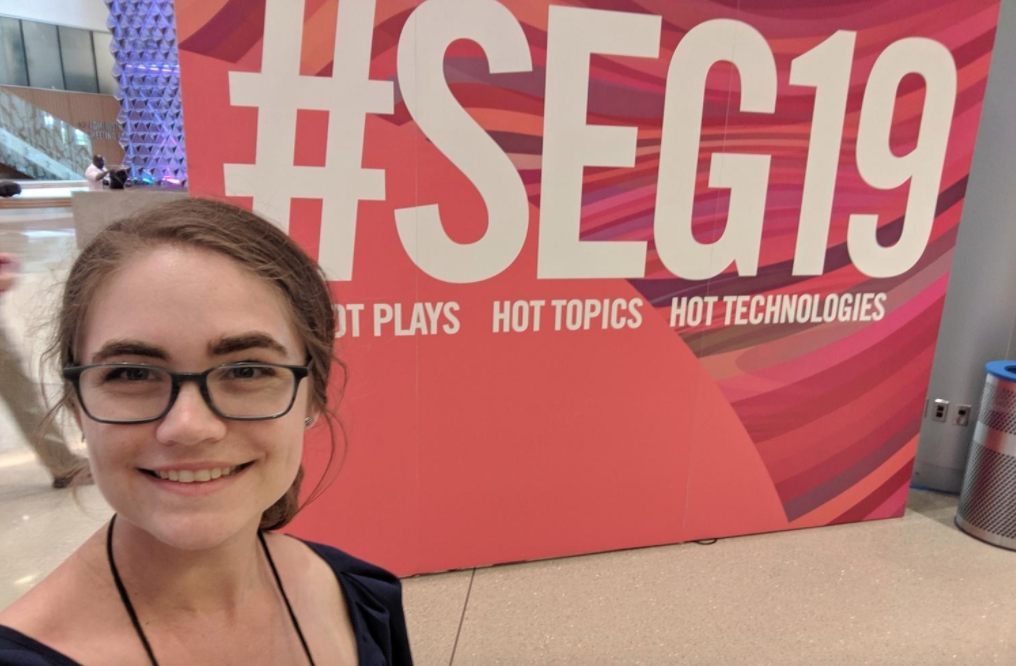Dr. Georgia Stuart is passionate about many things: mathematics, teaching, high-performance computing (HPC), increasing diversity in STEM. Seemingly unrelated, Dr. Stuart has thus far shown they need not be mutually exclusive.
Georgia Stuart didn’t set out to be a mathematician. The Oden Institute’s new postdoc had every intention of becoming a high school mathematics teacher. But a chance encounter with some partial differential equations led her to her true calling.
Stuart began her mathematics degree at a community college in California in 2007. Soon after, she transferred to UT Dallas to complete her bachelor’s of science degree and her teaching certification in high school math and computer science.
It was during her next academic step, a Masters of Arts in Teaching (MAT) degree at UT Dallas, that Stuart took a course in numerical differential equations with one of her future advisors, Dr. Susan Minkoff. That summer Dr. Minkoff invited her to participate in a summer research experience. Stuart was hooked.
“During that summer, I learned how exciting and creative mathematics research can be,” said Stuart. “I decided I wanted a career with a research component, rather than focusing exclusively on teaching.”
Shortly after, Stuart finished her MAT and enrolled in the PhD program at UT Dallas, advised by Dr. Minkoff and Dr. Felipe Pereira. Her thesis? How to make more efficient algorithms, that require less computing power, for seismic inversion.
Seismic inversion is the process by which geophysicists and mathematicians can infer the structure and composition of what’s below the earth’s surface. Like an ultrasound, they use generated seismic waves to “see” the structure of the subsurface and locate desirable resources--such as oil and gas reservoirs. However, methods that solve for a picture of the subsurface and that also give uncertainty information (like “error bars” on the earth picture) require vast computing resources on supercomputers.
Uncertainty information is critical because it tells scientists how confident they should be in the model at a particular location. If a region shows a promising reservoir, for example, but it has high uncertainty, it would be a gamble to drill in that region.
Some of these uncertainty methods, like Markov chain Monte Carlo (MCMC), operate on a “guess and check” structure. A picture of an earth model is proposed. Then the computer simulates a seismic wave traveling through that earth model and generates seismic data. That seismic data is compared to the true seismic data. If the generated seismic data is close enough to the true seismic data, the earth model is accepted and is used to quantify the uncertainty. If it’s not close enough, the algorithm might reject that earth model and begin again with a new one.
“It’s not an exaggeration to say that an MCMC algorithm for seismic inversion would take years on my desktop computer. A supercomputer, on the other hand, could reduce that time to a matter of weeks,” said Stuart.
Weeks on a supercomputer is still an enormous use of resources. Stuart’s PhD research focused on using approximations of the wave equation to reduce the amount of computing time necessary for a seismic inversion problem. In addition, the heavy use of HPC resources necessary for Stuart’s research sparked a keen interest in HPC methods, hardware, and workflows. Under the guidance of Dr. Christopher Simmons, former Deputy Director of the PECOS group at the Oden Institute and current Director of Cyberinfrastructure Researcher Support at UT Dallas, Stuart has spent considerable time learning best practices for programming and deploying code on HPC resources, like the Ganymede cluster at UT Dallas.
The cluster, built in 2018 from donated racks from Stampede1 at the Texas Advanced Computing Center (TACC), served as one host for Stuart’s PhD research experiments. The primary home for Stuart's considerable computing needs was the UT Dallas Seismology Group's HPC Optane cluster, funded by Dr. David Lumley, the Cecil and Ida Green Chair in Geophysics at UT Dallas, and Dr. Hejun Zhu, leader of the UTD Seismic Imaging Laboratory.
“I’m not sure what direction I want to take my career after my Oden Institute postdoc,” says Stuart, “but I’m sure it will involve HPC. I would love to have a career where I get to learn new areas of computational science and help other researchers with their HPC code and
deployment.”
In October 2020, Stuart joined the Oden Institute to work on another project that requires vast HPC resources: oil spill source location in the Computational Hydraulics Group with Dr. Clint Dawson. In oil spill source location, satellite images are used to pinpoint the source of an oil spill. However, satellite images are often difficult to interpret and can’t reveal the location of oil slicks if they are significantly below the surface of the water. Stuart is currently working on code to model how oil spills propagate in the ocean.
While Stuart’s days are focused on research, she maintains ties to her education and outreach roots. As a masters and PhD student, she directed the Women in Physics summer camps at UT Dallas for five years and led a STEM-focused Girl Scout troop.
Now, as a member of the new Diversity, Equity, Inclusion, and Outreach (DEIO) committee at the Oden Institute, she hopes to continue her work of promoting women and gender minorities in STEM at UT Austin.
“It is critical that we strengthen the pipeline for women and underrepresented gender and racial minorities entering STEM disciplines, starting at the K-12 level,” Stuart said.
